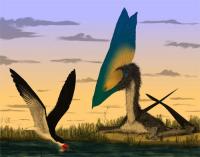
Physical and theoretical models show that pterosaurs (Thalassodromeus, right) could not meet the energy requirements of skimming, a rare feeding strategy practiced habitually by just a few extant Rynchops species (black skimmer, left). Credit: Image: Mark Witton In order to envisage the behaviors and lifestyles of now extinct animals, palaeontology often relies on extrapolating from modern species. Scientists identify shared anatomical features and infer from these shared ways of life. This method is often used to predict the diet of an extinct species based on comparisons of fossilized teeth, or used to conclude that species with large eyes were nocturnal. However, a new paper from Stuart Humphries, Richard Bonser, and colleagues, published in the open access journal PLoS Biology, provides a cautionary tale. Previous work on pterosaurs concluded that some species fed by skimming along the surface of the water with their mouths held open, but this paper overturns that inference, showing that this kind of feeding was highly unlikely to have occurred in pterosaurs after all.
Humphries, and colleagues from the Universities of Portsmouth, Reading, and Sheffield in the UK, investigated the feeding mechanisms of the pterosaurs using a variety of neat experimental and aerodynamic modelling techniques. They compared the forces acting on the modern skim-feeding bird, genus Rynchops, with those likely to occur on a pterosaur. Big was beautiful for the pterosaur, with evolutionary trends towards giant sizes. However, Humphries et al. show that the size of these colossal animals would have prevented them from feeding as previously described, as the drag experienced by a pterosaur over a ton would have imposed too great an energetic cost. The authors also reveal that the smaller, lighter pterosaurs that may have been able to overcome this drag barrier make equally unlikely skim feeders, as they lack the many adaptations of the neck and skull shown in modern skimming birds. The paper overturns the untested assum ption that drag is an unimportant cost of flight, offering, in turn, an explanation for the relative rarity of the skim-feeding strategy; found only in three modern birds, all of the same genus, Rhynchops.
The pterosaurs are an impressive group, with some stunning animals with wing spans over 12 meters across. The group represents a palaeontological success story; imagination-grabbing animals with a robust phylogeny, and recent discoveries, such as a pterosaur egg, which answer interesting questions about their life history. Humphries et al. have brought experimentation to a field where this is not always possible, and thereby uncovered a surprising and robust result.
Source : Public Library of Science
 Print Article
Print Article Mail to a Friend
Mail to a Friend
